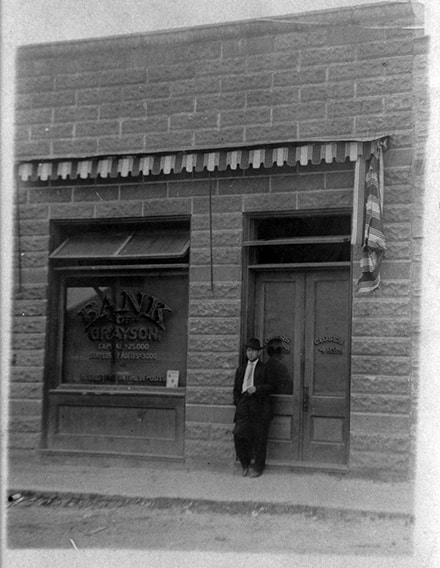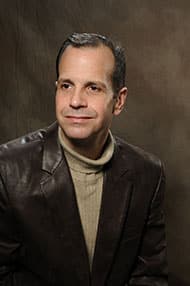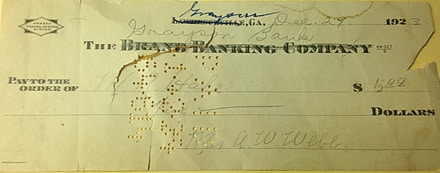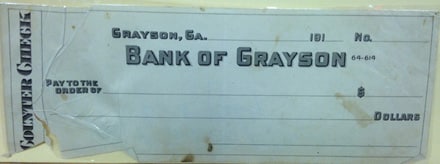
I wanted to know more immediately. The following statements, information, and facts are from many sources. They have been checked and compared among first hand accounts, period newspapers, Gwinnett County and Grayson family histories.
Mrs Alec Webb wrote this check in Lawrenceville, December 1923, six months before the bank failed. Mrs Webb seems not to have had any of her Bank of Grayson checks that day. This is an actual check from 1923 that was processed by the Bank of Grayson. Photo Courtesy of the Geraldine Cooper Estate.
Grayson’s able city leaders at the turn of the century, kept up with the times and adapted to the needs of its citizens, on a much larger scale than today. The population of Grayson in 1909 was approximately 300, in 1924 it was stated to be 800, and today it is about 2700. Plans for further city growth increased; as a result, in early 1906 the new Bank of Grayson was formed.

On October, 21, 1909 an article appeared in the NEWS HERALD about The Bank of Grayson, listing: William A. Cooper, president, W. P. Williams, vice president, and W. T. (Tom) Roberts, cashier (one year).
This is the first mention of Tom Roberts connected to The Bank of Grayson.
The years indicate he was most Likely hired as bank cashier about 1908. Peggy Moore Pharr (Mrs. Cecil Pharr) refers in her memoirs, written in the 1970’s, to The Bank of Grayson as that “Little Grayson Bank”. Tom Roberts was born November 9, 1885. He graduated from Auburn High School in 1904. He then attended Creighton Business College, and afterwards in 1907 worked as a bookkeeper.
In 1914 Tom Roberts married Grace Pharr. She was the daughter of George W. Pharr and Nitocris Woodward Pharr. The Pharr and Woodward families were very prominent in the history of Gwinnett County. George W. Pharr owned and operated the former Bogan mill for years. George Pharr also served 2 terms in the Georgia General Assembly. George and Nitocris Pharr moved to Florida in December 1920. They bought some real estate, a store, and went into the citrus business.
Going into 1924 the bank had made it through the slump and hardships caused by the troubled cotton crops of 1921 and 1922, and the unforgiving drought of 1925. Business conditions had started to decline, but The Bank of Grayson did start to prosper again. Many other banks in Georgia and across the South did not fare as well and were forced to close.
THE NEWS HERALD reported in June 1924 that The Bank of Grayson directors were: Alexander W. Webb, J. A. Jacobs, T. A. Pate, W. R. Roberts, and W. T. Roberts. W. R. Roberts was the father of Tom Roberts. THE NEWS HERALD also reported in 1924, “The Bank of Grayson, is capitalized at $40,000.00 and had a $10,000.00 surplus”.
Prior to 1924, Tom Roberts had served as cashier and trusted employee for The Bank of Grayson for many years. In 1923 or early 1924 he moved his family to Florida and worked in the insurance business, also helping his wife’s family in the citrus business. Besides her parents move in 1920, other members of Grace Roberts family had relocated to Florida.
During his years in Grayson, Tom Roberts was a well respected citizen and community leader. He was a member of Grayson Methodist Church, the Grayson Masonic Lodge and, a Shriner. Tom Roberts was in addition, a member of The Independent Order of Odd Fellows, who once had a very active lodge during the early years of growth in Grayson. The Independent Order of Odd Fellows very civic minded. They were responsible for having the brick veneer installed on Grayson School, as well as many other town improvements. Note: There is only one IOOF lodge left in the world, it is in Scotland.
Various sources say Tom Roberts was the Director and Chairman of Liberty Loan Company, the location and years involved could not be obtained. In Grayson, he owned an insurance agency, was a dealer in local area real estate, and involved in a large guano (fertilizer) business. Guano was a large part of Grayson economy, and of course cotton. In an interview with John J. Cofer, written in the late 1950’s, Mr. Cofer stated that at the heighth of Grayson’s growing years, the L&L Railroad shipped cotton and guano out at a large pace… Mr. Cofer was one of Grayson’s leading citizens and owned a large mercantile store for many years.
Mr. Cofer was also a Justice of the Peace well into his golden years. He performed many weddings through the years, many late at night with his wife “Mrs. Effie” as witness. The first couple he married was in front of his store, with the bride and groom sitting in the back seat of the car… yes, the father of the bride might be in hot pursuit! There are some native Grayson folk who have never heard that story, and our new citizens will love hearing it as part of the history of their new home – that story for another day.
Tom and Grace Roberts were not in Florida very long. The bank directors, town fathers, and other prominent citizens asked Tom Roberts to please return to Grayson. They were sure that he could save the bank from folding up and stop the slump. Upon his return to Grayson, he was made president of The Bank of Grayson.
The plan that Tom Roberts came up with made it appear he had brought the bank back to life. Bank directors were positive they had used excellent judgment in bringing Tom back. What President Tom Roberts had been doing to obtain money to operate the bank was to sign various people’s names on fake notes of security. People in Grayson agreed he had not used the money for himself, just to keep the bank open. They were sure! Accounts from many people with first hand knowledge, said that Tom had found that Bank Examiners were coming soon. He discovered that they would arrive on Wednesday, June 4, 1924, after the Tuesday holiday.
His actions were illegal, to say the least. The whole affair became more serious when a depositor sought to withdraw $1800.00. The problem was that only $300.00 was in the safe. Even with all the situations and problems at hand, Grayson citizens still believed in Tom Roberts. Statements like, “Tom Roberts ain’t short”, “Don’t worry, we won’t loose a thing after this is cleared up”, and, “That ‘ole Tom Roberts, he’ll be back”. The citizens of Grayson were loyal to one of their own, but, most fortunate for them was that The Bank of Grayson was a member of the Federal Reserve.
At the close of business on Monday, June 2, 1924, Tom Roberts told his wife Grace, that he was going to Atlanta and would be back Tuesday night. Tuesday, June 3, 1924 was a legal holiday and the bank would be closed. I have searched source after source but have not been able to find what the holiday was.
Tom Roberts had not returned by Wednesday morning to open the bank as usual. That started a run on The Bank of Grayson. Even with extra help brought in, so many depositors withdrew their accounts that the bank was forced to close. Saturday, June 7, 1924, a signed statement was posted on the doors of The Bank of Grayson by three directors. The statement read to the effect, the bank is in the hands of the state superintendent of banks. Then they closed the doors to the bank on Saturday afternoon as depositors were seeking admittance to draw out their deposits.
There is no reference or positive source that tells the events of the next days, weeks, or months. My first hand interviews all stated, then OUR bank closed for good.
Many of the people interviewed could still remember “to the penny”, how much their families and friends lost. Mabel Langley King, remembered how much her older sister Rosa Langley Bell lost. Geraldine Cooper remembered how much her father, Columbus Cooper, lost. After she passed away, I found in her father’s papers the exact amount she had always told me.
Tom Roberts was described as being 38 years old, small and chunky, about 200 pounds, and light hair and eyes. He was last seen in Georgia on Tuesday evening in a taxi in Atlanta. In a very odd twist of events, the sighting was by Tom’s brother in law, W. W. Pharr who lived in Atlanta. He also had a brother that lived in Atlanta, Glenn Roberts. One person stated to me that his wife thought he probably had become temporarily mentally unbalanced.
The police and other authorities conducted a search for him. Most of Grayson’s citizens were sure he would be back and able to clear his name. That never happened.
Tom Roberts never came back, he could not clear his name. The events of what happened to Tom were told to me by a Roberts descendent, and also by the Pharr family. The people of Grayson also tell of the same fate. Tom Roberts left Grayson and Georgia. It is not known where he went then. He ended up living a secret and sparse life in Boston, Massachusetts. He took the name of “Walter Rose”, worked in a restaurant and lived in a rented room.
Peggy Moore Pharr states in her aforementioned memoirs, “I remember Cecil and I carrying Grace, Mr. Roberts (Tom’s father) to Atlanta & Mr. Roberts had a package. I later learned he was mailing Tom’s winter clothes, overcoat, etc., to him. The family never received mail from him that was known of, they thought the mail was being watched.”
Tom Roberts seems to have had some limited contact with his brother, Raymond Reid Roberts, M.D. The dates Dr. Roberts lived in Grayson and Louisiana have not been documented. It is known he was living in Grayson in 1936. He attended the birth of Kathleen Rogers. Her mother had lost more than five babies before Kathleen was born. She too was a fragile baby, Dr. Roberts knew how to proceed. He made an incubator like he had seen at Tulane. The “Grayson version” was made out of a fruit crate, quilts, and an electric light bulb. Kathleen grew into a wonderful child, and delightful young lady, and graduated Grayson High School in 1954. I think this is probably the first incubator ever used in Grayson.
Tom Roberts died of a cerebral hemorrhage on January 25, 1925. He was only known as Walter Rose and no one knew where he came from. He would have been buried in a paupers grave but, his boss at the restaurant offered to pay for his funeral. Just before he was to be buried his landlady found a letter with his brother, Dr. Roberts address on it. A wire was sent to Dr. Roberts, and he confirmed it was his brother.
Dr. Roberts had his brother Tom’s body shipped back to Grayson. Many people have told me that most of Grayson turned out to meet the train. Also, his funeral was very large. He is buried in the Roberts family plot at Chestnut Grove Baptist Church, next to his wife Grace.
The majority of those interviewed and my older family members told me, without hesitation nor reservation, that Grayson stood by the Roberts family. No matter what Tom had done they showed Grace Roberts Pharr and their three children respect and understanding, not pity. I was told by a member of the family, the most grief anyone gave Grace was her own father. He had also lost money and could not abide what his son in law had done.
Thus this sad, but true story is written to further the knowledge of Grayson’s history, as it was so freely shared and passed on to me.
Steven P. Starling is the City of Grayson Historian, Past President of Gwinnett Historical Society and a freelance writer.
Add your piece of history below!
Photograph of a counter check from the Bank Of Grayson. Photo Courtesy of the Geraldine Cooper Estate.



